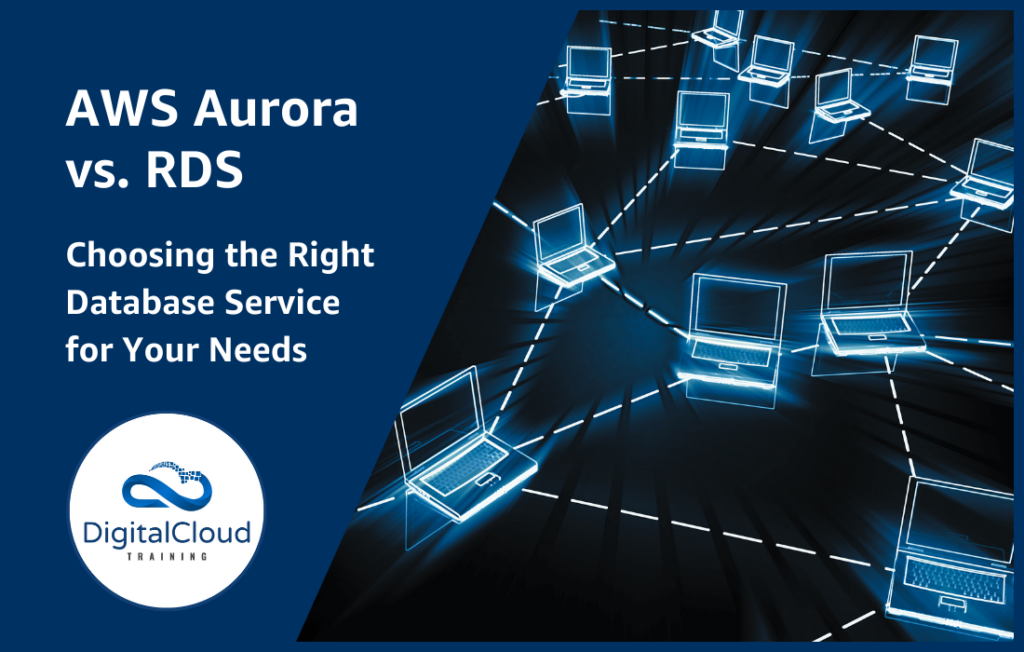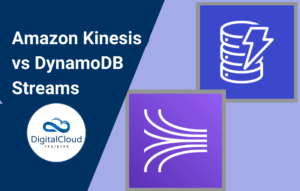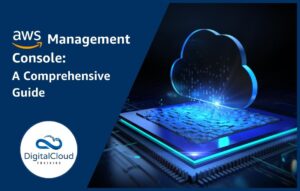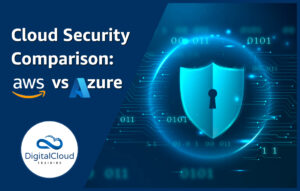AWS Aurora vs. RDS: Choosing the Right Database Service for Your Needs
Please use the menu below to navigate the article sections:

Dive right in with us as we explore the world of AWS database services, focusing specifically on two standout options: Aurora and RDS. These are both managed services from Amazon, sitting comfortably under the DaaS (Database as a Service) banner.
If you’re finding yourself tangled in the Aurora vs RDS decision-making process, wondering which will serve your business and tech needs best, you’re in the right place. This article is your roadmap to clarity.
Here, we’ll unpack Aurora and RDS, spotlight their importance, weigh their strengths and weaknesses, and offer practical, real-world examples to help illustrate which service is a better fit for specific situations. So, without further ado, let’s kick things off with AWS Aurora.
I. Overview of Amazon Aurora
A. AWS Aurora Benefits
1. Performance
Aurora’s optimized architecture delivers quick and consistent database performance even with enormous workloads. Its use of distributed storage and concurrent query processing significantly enhances throughput.
2. Scalability
Simple Aurora instances do not have built-in vertical scaling if CPU storage or memory runs out; it only provides storage autoscaling. However, Aurora serverless provides automatic scaling if any of the resources run out.
3. High Availability
Distributed, fault-tolerant Aurora provides high availability. It handles failover and duplicates data across AZs. Aurora has support for the Aurora global database, a fully managed solution in which read replicas of your DB are placed in different AWS regions for low latency and high availability.
4. Durability
Aurora’s automated and incremental backups ensure data durability. It can restore your database to any point during retention. Due to built-in multi-AZ support, the secondary instance automatically takes over with minimal downtime if the primary instance goes down.
B. Comparison of Amazon Aurora with other database services
Aurora has several advantages over traditional RDBMS and other cloud-based database services:
1. Performance
Due to optimized storage and query execution, Aurora outperforms typical RDBMS systems.
2. Scalability
Aurora scales better than RDBMS systems. Aurora serverless automatically adds resources for escalating workloads.
3. Cost
Aurora’s strong performance and low infrastructure requirements make it cheaper than standard RDBMS solutions.
4. Flexibility
Aurora offers a good blend of performance and affordability, although RDS may be more flexible. RDS supports MySQL, PostgreSQL, Oracle, SQL Server, MariaDB, and others. RDS is superior if your application needs a database engine not supported by Aurora.
C. Use cases for Amazon Aurora
Some use cases where Aurora is highly recommended are:
1. eCommerce applications
Aurora’s performance and scalability make it appropriate for eCommerce environments with high transaction volumes and fast response times.
2. SaaS applications
Aurora’s multi-tenant workload handling and automated scaling make it excellent for SaaS services that scale dynamically based on consumer demand.
3. Gaming applications
Real-time gaming applications benefit from Aurora’s high throughput and low latency.
II. Overview of Amazon RDS
A. AWS RDS Benefits
Amazon RDS is the managed database service of AWS and provides valuable benefits, including following:
1. Simplified Database Management
RDS takes care of hardware provisioning, database setup, patching, and backups, so developers can focus on their applications.
2. Storage autoscaling
If you enable this option in RDS, as soon as your disk space starts to exceed the allocated volume, RDS will automatically allocate more storage to your RDS instance.
3. Automated Backups and Software Patching
RDS automatically backs up and provides point-in-time recovery, assuring data durability and allowing database restoration. It patches databases with the newest security fixes.
4. Built-in Monitoring
RDS monitors database performance indicators, resource utilization, query execution, and database health.
B. Comparison of AWS RDS with other database services
1. Ease of Management
RDS is a completely managed service that simplifies database administration unlike traditional DBMS, which requires manual management and configuration.
2. Scalability
RDS can manage growing workloads and traffic. Traditional DBMS may need more resources to scale vertically or horizontally.
3. Availability
Automated backups, replication, and fault-tolerant infrastructure make RDS highly available and durable. Traditional DBMS may need more configuration to attain equal availability and durability.
4. Cost
RDS’s pay-as-you-go concept lets users match expenses to usage. Traditional DBMS have licensing and maintenance costs.
5. Database Engine Support
RDS supports MySQL, PostgreSQL, Oracle, and SQL Server for application flexibility. Traditional DBMS may restrict database engines.
C. Use cases for Amazon RDS
Here are some real-world use cases where RDS is highly recommended:
1. Small to large-scale applications
Startups and small organizations looking for a simple, scalable, and affordable database solution can choose RDS. It handles massive enterprise workloads with strong availability and durability.
2. Example use cases
Web applications, e-commerce platforms, content management systems, mobile app backends, and data analytics apps employ RDS.
3. WordPress website example
RDS provides a stable and scalable architecture for content management and user data storage for WordPress websites.
III. Side by side comparison of Aurora and RDS
A. Differences between Aurora and RDS in terms of performance, scalability, availability, security, and cost
| Aurora | RDS | |
| Performance | Superior in high-performance environments, ideal for heavy-duty e-commerce and analytics platforms. | While slower than Aurora, RDS performs well for most workloads. Best suited for low-performance applications that don’t require high scalability or responsiveness. |
| Scalability | Provides both horizontal and vertical scalability. Fits rapidly expanding, dynamically scaling applications | Scalable, but requires more manual intervention than Aurora. Suited for applications with predictable growth patterns where occasional scaling suffices. Does not offer built-in support for multi-AZ instances |
| Availability | Replicates data across region AZs for high availability. Best for critical enterprise systems requiring continuous availability. Supports multi-region replication with no manual intervention in Aurora serverless. | Default model places the database in a single availability zone. Multi-AZ deployments need to be manually enabled and come with extra charges. Multi-Region Read Replicas require manual management of replicas in each region. |
| Security | Offers strong encryption at rest and in transport, AWS IAM access limits, and AWS KMS key management. | Also supports AWS KMS integration, IAM access control, and encryption at rest and in transit. Meets industry standards for security-sensitive applications without Aurora’s encryption. |
| Cost | Due to its performance and distributed architecture, Aurora costs more than RDS. Costs depend on instance type, storage space, and replication. Ideal when performance and scalability outweigh cost. | Offers a range of budget- and performance-based instance types and storage options. More suited to cost-optimized, reliable applications. |
B. Use cases for each service based on their differences
Here are some real-world examples where Aurora should be preferred over RDS:
- E-commerce platforms and data-intensive applications require high query performance and throughput.
- Content management systems and analytics platforms need horizontal scalability and read replicates to handle growing read traffic.
- Aurora’s replication across many availability zones ensures data availability even if an AZ fails, making it ideal for mission-critical systems.
- Applications with high concurrency or frequent write operations benefit from Aurora’s distributed design and optimized storage engine.
RDS is a preferred choice in the below use cases:
• Small web apps and company systems with minimal performance and scalability needs.
• RDS is cost-effective for non-scaling workloads that can be managed manually.
• Use cases with price constraints, as RDS is cheaper than Aurora.
• Applications that need a standard database environment without Aurora’s enhanced features.
IV. Factors to Consider When Choosing Between Aurora and RDS
1. Application requirements and workload characteristics
If your application requires advanced features, high-performance, and distributed architecture, choose Aurora. If your workload is modest and doesn’t require the advanced capabilities of Aurora, RDS may be a suitable choice.
2. Scalability and performance need
Aurora is the preferred choice if you need horizontal and vertical scaling with automatic read replicas and easy instance and storage capacity growth. For predictable growth applications with manual intervention, RDS scaling may be sufficient.
3. Budget constraints
If budget is a primary concern and your use case doesn’t require the advanced capabilities of Aurora, RDS offers more cost-effective options that can be tailored to your budget and performance needs.
4. Technical expertise and resources
If you have a team with extensive experience in managing traditional databases and want to leverage their existing skills and tools, RDS may be the preferred choice. However, if you are open to learning and adopting new technology with a distributed architecture, Aurora can be a viable option, especially if you have the resources and willingness to invest in acquiring the necessary expertise.
V. Conclusion
Throughout this article, we’ve journeyed together through the complexities and nuances of AWS Aurora and AWS RDS, comparing their performance, scalability, availability, security, and cost implications.
Knowing your application’s special needs, getting the hang of workload traits, recognizing budget caps, and using your team’s tech skills are all key parts in choosing between these two options.
Amazon Aurora shines for distributed, high-performance applications. Its resilience and flexible scaling mechanisms make it a robust choice for demanding workloads. Meanwhile, Amazon RDS comes into its own for small to medium workloads with predictable growth and budget constraints, or when traditional database management skills are at play.
Here’s what it all boils down to: your special needs will decide if Aurora or RDS is your winner. We suggest a detailed check of your application, thoughtful understanding of your unique situation, and a smart choice that fits your business goals.
Ready to Take Your Tech Career to the Next Level?
At Digital Cloud Training, we’re dedicated to your success. Our courses offer up-to-date content, equipping you with the expertise to stand out in the competitive tech job market.
Our On-Demand Training allows you to learn at your own pace, fitting seamlessly into your schedule. Dive into the world of cloud computing whenever and wherever suits you best.
But we don’t stop at theory. Our Challenge Labs provide practical, real-world scenarios where you can apply your newfound knowledge without the risk of unexpected cloud costs. Gain hands-on experience and sharpen your skills.
For those seeking an immersive experience, our Cloud Mastery Bootcamp delivers live, job-ready training. Led by industry experts, this accelerated program can get you certified faster than you thought possible.
It’s time to propel your tech career forward. Join us at Digital Cloud Training and unlock your full potential in the world of cloud computing.





Responses